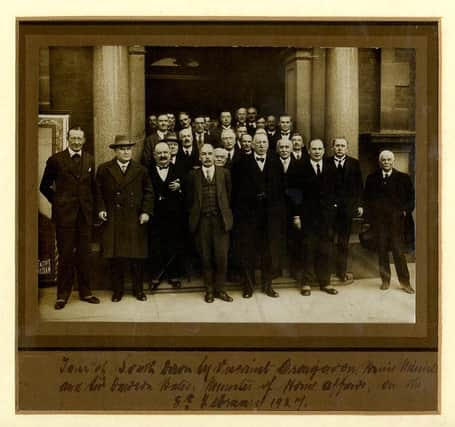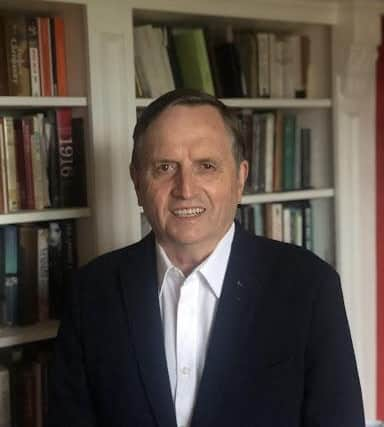Brian M Walker: Why this 1927 image of James Craig in Newry deserves to be appreciated


They are standing in front of the town hall after a reception and lunch for their visitor.
At this time Newry council was a rare example of what we would call today a ‘power-sharing’ council with a unionist chairman, William Robinson, and a nationalist vice-chairman, Terence Ruddy. The council was made up of six nationalist, six unionist and six labour councillors.
Advertisement
Hide AdAdvertisement
Hide AdThis visit of Craigavon arose as part of a 10-day tour to various parts of Northern Ireland. It occurred when, after the tumultuous period 1920-25, there were efforts to encourage political accommodation and reconciliation. These efforts achieved certain success, as seen in Craigavon’s visit to Newry in 1927.


The years 1920-22 witnessed considerable violence and political conflict in Newry and district. On 19 December 1921, under chairman Hugh J. McConville, Newry Urban Council passed a motion pledging loyalty to Dáil Éireann.
Consequently, in April 1922 the government dissolved the council, along with other councils which had taken similar action, and appointed a town commissioner.
The council was restored in early 1923. A following election saw the return of 12 nationalist and six unionist councillors. The next years were marked with much political uncertainty over the Boundary Commission. The outcome in late 1925 of no change to existing boundaries was met with disappointment by nationalists and relief by unionists.
Advertisement
Hide AdAdvertisement
Hide AdIn January 1926, however, the election for Newry council had surprising results, reflecting the relevance for many of social and economic issues over constitutional matters.
The outcome was the return of not only six nationalist and six unionist councillors but also six labour councillors, led by W.F. Cunningham, chairman of the local Trades and Labour Council and president of the local branch of the Legion of Irish Ex-Servicemen.
This resulted, after much debate, in the election of unionist William Robinson as chairman, the first unionist chairman for over 20 years. He was managing director of the Newry firm of Foster & Co. Ltd. The nationalist Terence Ruddy was elected vice-chairman. Appointments to standing committees resulted in three members of each party in each committee.
On 24 January 1927, James Craig, recently elevated to the peerage as Viscount Craigavon, attended a public luncheon in Belfast City Hall.
Advertisement
Hide AdAdvertisement
Hide AdHe announced plans for a 10-day tour of local authorities to assure them that their interests would not be neglected by the government. He would be accompanied by Sir Dawson Bates, minister of home affairs.
In concluding remarks he declared: ‘Not only did peace reign in their midst, but Protestants and Roman Catholics were working together for the common good and Ulster might now be looked upon as one of the best parts of the Empire’.
On the morning of 8th February Craigavon and Bates travelled to Kilkeel followed by a visit to Warrenpoint where they were greeted by members of the urban council.
Edward Byrne, nationalist chairman, welcomed Craigavon and stated: “They might not always have seen eye to eye on political matters but they believed that his lordship was, and would continue to be, on the side of peace and goodwill”.
Advertisement
Hide AdAdvertisement
Hide AdThe nationalist vice-chairman, Francis Connolly, paid tribute to Bates as “the man who, in the darkest hour in the history of their province, with his back to the wall, used his strong hand in putting down crime of all sorts”.
The two men then travelled to the town hall in Newry. First, they met chairman William Robinson and members of the urban council in private conference.
At 2.00 pm the visitors and a large representative company were entertained to luncheon by Robinson, "the catering being excellently done by Mrs Truesdale, of the Clanrye Café Newry”.
Present were members of the council, including vice-chairman Terence Ruddy and W.F. Cunningham, the Newry Port and Harbour Trust, and the Newry Chamber of Commerce..
Advertisement
Hide AdAdvertisement
Hide AdAfter lunch, according to the Newry Reporter, the chairman, William Robinson, "submitted the usual loyal toast, which was followed by the singing of ‘God save the King’’’ while the Frontier Sentinel referred only to the toast of ‘The King’.
Robinson next proposed ‘Prosperity to Northern Ireland’ and then made a speech, and thanked the government for their "liberal grants”.
Craigavon replied, to express gratitude for their welcome. He urged people to work for prosperity for Northern Ireland.
He added: "Might he also say that they in Ulster of all creeds and classes were sufficiently broadminded to say that they also hoped for prosperity for the whole of Ireland (applause)”.
Advertisement
Hide AdAdvertisement
Hide AdThis visit of Craigavon to Newry in February can be seen as evidence of efforts to improve relations after the turmoil of 1920-22 and the demise of the Boundary Commission in late 1925.
These efforts would continue until the 1930s when a number of factors, internal and external, would cause politics in Northern Ireland to become very divisive and confrontational.
As regards Newry, however, we can note that politics continued along conciliatory lines.
Shortly before the January 1929 urban elections it was announced that William Robinson would stand down and leave Newry. He had been appointed managing director of the Bank Buildings department store in Belfast.
Advertisement
Hide AdAdvertisement
Hide AdAt his last council meeting tribute was paid to the "able, dignified and impartial manner” in which he had discharged the duties of the chair. In May he was presented with an inscribed silver salver for his services to the town.
Robinson, who died in 1961, was knighted in 1946, in recognition of "outstanding public service in many fields”.
The 1929 election saw again the return of six councillors from each party. The new chairman was nationalist Hugh J. McConville, a former chairman, a justice of the peace, and, later in the year, a deputy lieutenant for Co. Down. The unionist James Boland was elected vice-chairman.
At the 1932 election, the return of the parties was the same, with no contest. Again, a nationalist chairman and unionist vice-chairman were elected. In 1938 labour councillor W.F. Cunningham was elected chairman.
Advertisement
Hide AdAdvertisement
Hide AdThis 1927 photograph allows us to recall a special, largely forgotten, moment in the history of Newry and Northern Ireland. It deserves to be appreciated.
Brian M. Walker is Professor Emeritus of Irish Studies at Queen’s University Belfast. This article is based on a longer article in ‘The legacy: Newry 1920-30’, published by Newry and Mourne Museum. The photograph is published with permission of the museum.